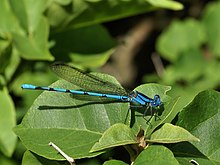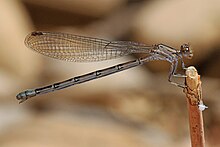Argia
| Argia | |
|---|---|

| |
| Argia anceps | |
| Scientific classification | |
| Kingdom: | Animalia |
| Phylum: | Arthropoda |
| Class: | Insecta |
| Order: | Odonata |
| Suborder: | Zygoptera |
| Family: | Coenagrionidae |
| Subfamily: | Argiinae |
| Genus: | Argia Rambur, 1842 |
Argia is a genus of damselflies of the family Coenagrionidae and of the subfamily Argiinae. It is a diverse genus which contains about 114 species and many more to be described. It is also the largest genus in Argiinae. They are found in the Western Hemisphere. They are commonly known as dancers. Although the genus name comes from Ancient Greek: ἀργία, romanized: argia, lit. 'laziness',[1] dancers are quite active and alert damselflies. The bluer Argia species may be confused with Enallagma species.
Characteristics[]
This genus of damselflies are known as dancers because of the distinctive jerky form of flight they use which contrasts with the straightforward direct flight of bluets, forktails and other pond damselflies. They are usually to be seen in the open where they catch flying insects on the wing rather than flying about among vegetation picking off sedentary prey items. They tend to land and perch flat on the ground, logs and rocks.[2] When perched, they usually hold their wing slightly raised above the abdomen.[3]
The males of most species are some combination of black and blue but they can easily be told from similarly coloured bluets by their mode of flight. Some species have red eyes and others a copper-coloured thorax. Many species have humeral stripes, either notched or forked at the end or narrowed in the centre. The wings have short petioles and are relatively broad close to the base.[2] Unlike most of the Coenagrionidae, dancers are often associated with flowing water.[3]

Argia adamsi male

Argia fissa male

Argia fissa female

Argia oculata, male purple form

Species[]
The genus includes the following species:
- Calvert, 1902
- Argia agrioides Calvert, 1895 - California Dancer
- Argia alberta Kennedy, 1918 - Paiute Dancer
- Hagen in Selys, 1865
- Argia anceps Garrison, 1996
- Argia apicalis (Say, 1840) - Blue-fronted Dancer
- Argia barretti Calvert, 1902 - Comanche Dancer
- (Calvert, 1909)
- Argia bipunctulata Hagen, 1861 - Seepage Dancer
- Calvert, 1909
- (Hagen, 1861)
- Daigle, 1995 - Yaqui Dancer
- Calvert, 1909
- Calvert, 1902
- Selys, 1865
- Selys, 1865
- (Rambur, 1842)
- Selys, 1865
- Calvert, 1902
- Argia cuprea (Hagen, 1861) - Coppery Dancer
- Navás, 1934
- Calvert, 1902
- Selys, 1865
- Förster, 1914
- Selys, 1865
- Argia emma Kennedy, 1915 - Emma's Dancer
- Fraser, 1946
- Argia extranea (Hagen, 1861) - Spine-tipped Dancer
- Selys, 1865
- Förster, 1914
- Calvert, 1907
- Navás, 1934
- Hagen in Selys, 1865
- Argia fumipennis (Burmeister, 1839) - Variable Dancer
- (Selys, 1854)
- (Hagen, 1861)
- Daigle, 1991
- Calvert, 1907
- Calvert, 1909
- Fraser, 1946
- Calvert , 1899 - Harkness's Dancer
- Calvert, 1909
- Calvert, 1902
- Argia hinei Kennedy, 1918 - Lavender Dancer
- Förster, 1914 - Huanacina Dancer[4]
- Argia immunda (Hagen, 1861) - Kiowa Dancer
- Rambur, 1842
- Hagen in Selys, 1865
- Calvert, 1902
- Navás, 1934
- Fraser, 1946
- Selys, 1865
- Hagen in Selys, 1865
- Calvert, 1909
- Hagen in Selys, 1865
- Ris, 1913
- Calvert, 1907
- Ris, 1916
- Calvert, 1909
- Argia lacrimans (Hagen, 1861) - Sierra Madre Dancer
- Argia leonorae Garrison, 1994 - Leonora's Dancer
- Selys, 1865
- Navás, 1924
- Argia lugens (Hagen, 1861) - Sooty Dancer
- Hagen in Selys, 1865
- Fraser, 1946
- Selys, 1865
- Argia moesta (Hagen, 1861) - Powdered Dancer
- Hagen in Selys, 1865
- Argia munda Calvert, 1902 - Apache Dancer
- Argia nahuana Calvert, 1902 - Aztec Dancer
- Calvert, 1909
- Hagen in Selys, 1865
- Argia oenea Hagen in Selys, 1865 - Fiery-eyed Dancer
- Hagen in Selys, 1865
- Argia pallens Calvert, 1902 - Amethyst Dancer
- Calvert, 1902
- Garrison, 1994 - Pima Dancer
- Calvert, 1907
- Argia plana Calvert, 1902 - Springwater Dancer
- Calvert, 1907
- Calvert, 1902
- Hagen in Selys, 1865
- Selys, 1865
- Navás, 1920
- Argia rhoadsi Calvert, 1902 - Golden-winged Dancer
- Calvert, 1902
- Tennessen, 2002
- Garrison, 1994 - Sabino Dancer
- Argia sedula (Hagen, 1861) - Blue-ringed Dancer
- Hagen in Selys, 1865
- Calvert, 1909
- Hagen in Selys, 1865
- Calvert, 1909
- Calvert, 1907
- Calvert, 1909
- Argia tarascana Calvert, 1902 - Tarascan Dancer
- Meurgey, 2009
- Calvert, 1907
- Argia tezpi Calvert, 1902 - Tezpi Dancer
- Hagen in Selys, 1865
- Argia tibialis (Rambur, 1842) - Blue-tipped Dancer
- Selys, 1865
- Argia tonto Calvert, 1902 - Tonto Dancer
- Argia translata Hagen in Selys, 1865 - Dusky Dancer
- Calvert, 1909
- Calvert, 1902
- Calvert, 1907
- Navás, 1935
- Selys, 1865
- Förster, 1914
- Argia vivida Hagen in Selys, 1865 - Vivid Dancer
- Garrison, 1996 - Westfall's Dancer[5]
- Garrison and von Ellenrieder, 2007[6]
Additionally a fossil member of this genus is known from the Miocene Mexican amber[7]
Notes[]
- ^ "Greek Dictionary Headword Search Results". Perseus Project. Retrieved 25 October 2010.
- ^ Jump up to: a b Paulson, Dennis (2009). Dragonflies and Damselflies of the West. Princeton University Press. pp. 140–141. ISBN 978-1-4008-3294-1.
- ^ Jump up to: a b Eaton, Kaufman & Bowers (2007). Kaufman Field Guide to Insects of North America. HMH. ISBN 978-0-618-15310-7.
- ^ von Ellenrieder, N. (2009). "Argia huanacina". IUCN Red List of Threatened Species. 2009: e.T159102A5313103. doi:10.2305/IUCN.UK.2009-2.RLTS.T159102A5313103.en. Retrieved 24 December 2017.
- ^ Paulson, D. R. (2009). "Argia westfalli". IUCN Red List of Threatened Species. 2009: e.T164974A5949503. doi:10.2305/IUCN.UK.2009-2.RLTS.T164974A5949503.en. Retrieved 24 December 2017.
- ^ "Argia yungensis Garrison & von Ellenrieder, 2007". Global Biodiversity Information Facility. Retrieved 18 September 2020.
- ^ Zheng, Daran; Nel, André; Jarzembowski, Edmund A.; Chang, Su-Chin; Zhang, Haichun; Wang, Bo (2019-01-02). "Exceptionally well-preserved dragonflies (Insecta: Odonata) in Mexican amber". Alcheringa: An Australasian Journal of Palaeontology. 43 (1): 157–164. doi:10.1080/03115518.2018.1456562. ISSN 0311-5518.
References[]
- Martin Schorr; Dennis Paulson. "World Odonata List". University of Puget Sound. Retrieved 12 Oct 2018.
- "North American Odonata". University of Puget Sound. 2009. Archived from the original on 11 July 2010. Retrieved 5 August 2010.
- Westfall, Minter J. Jr.; May, Michael L. (1996). Damselflies of North America. Scientific Publishers. ISBN 0-945417-93-4.
- "Odonata Central". Retrieved 2018-02-16.
- Coenagrionidae
- Taxa named by Jules Pierre Rambur
- Zygoptera genera